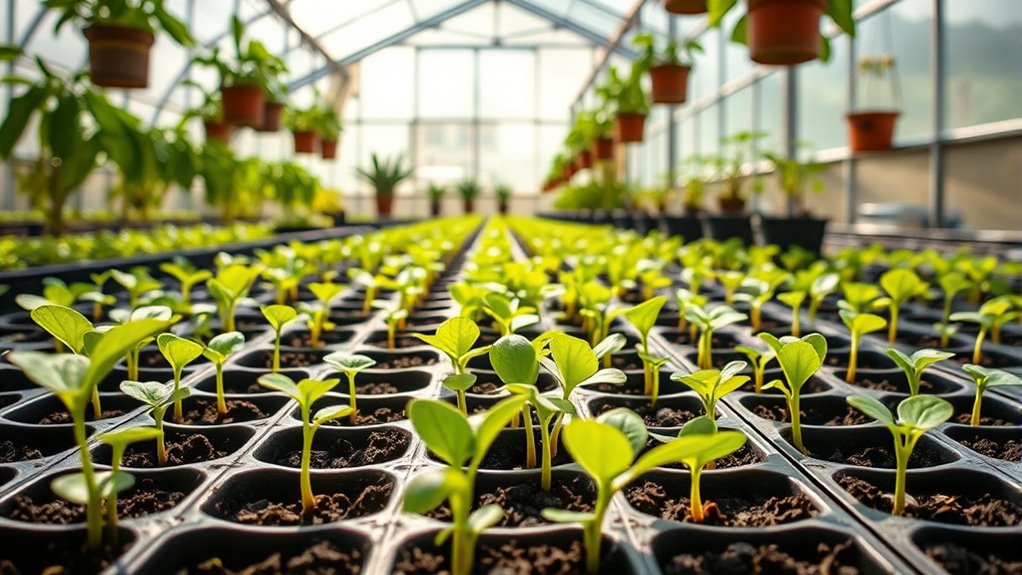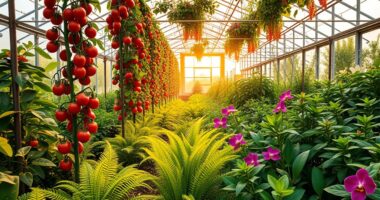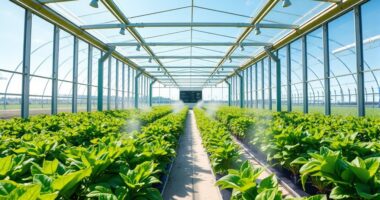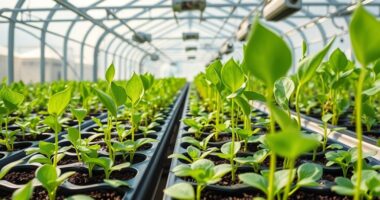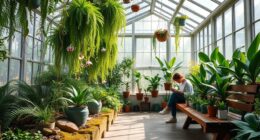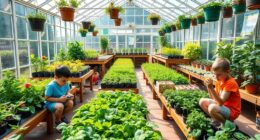To grow strong seedlings in a greenhouse, make certain you provide a controlled environment with proper ventilation to prevent excess humidity and disease. Use quality seed-starting mixes rich in nutrients and supplement with diluted fertilizer as needed. Maintain ideal temperatures around 65-75°F and humidity levels between 50-70%. Regular airflow encourages healthy stems and reduces mold risks. For detailed tips on creating ideal conditions, continue exploring proven strategies for thriving greenhouse seed starts.
Key Takeaways
- Use a high-quality seed-starting mix with balanced nutrients to support healthy germination.
- Ensure proper ventilation with vents or fans to prevent excess humidity and fungal diseases.
- Maintain optimal temperature (65-75°F) and humidity (50-70%) for robust seedling growth.
- Regularly monitor seedlings for nutrient deficiencies and supplement with diluted liquid fertilizer if needed.
- Adjust ventilation based on weather conditions to create a stable, stress-free environment for seedlings.

Starting seeds in a greenhouse gives you a head start on the growing season by providing a controlled environment that promotes healthy germination and early growth. To guarantee your seedlings develop into strong, vigorous plants, paying attention to seedling nutrition is essential. Proper nutrition begins with choosing a high-quality seed-starting mix that offers balanced nutrients, including nitrogen, phosphorus, and potassium. As your seedlings grow, you may need to supplement with a diluted liquid fertilizer to boost their development, especially if the initial soil lacks certain nutrients. Keep an eye on the seedlings’ leaves; yellowing or stunted growth often signals nutrient deficiencies that need correction. Providing adequate seedling nutrition helps develop strong root systems and sturdy stems, setting a solid foundation for when they’re transplanted outdoors. Seedling nutrition is vital for ensuring healthy development from the very beginning.
Equally important is greenhouse ventilation, which plays a vital role in maintaining ideal conditions for seedling growth. Good ventilation prevents excess humidity, which can lead to fungal diseases like damping-off. It also ensures a consistent supply of fresh air, reducing the risk of mold and mildew. You want to keep the air circulating gently but continuously, especially during warm or humid days. Proper ventilation helps regulate temperature and humidity levels, which are essential for healthy germination and early seedling development. If your greenhouse lacks natural airflow, consider installing fans or vent openings that can be opened and closed as needed. Proper airflow also strengthens seedlings by encouraging thicker stems, helping them withstand wind and weather once transplanted outside.
Monitoring your greenhouse’s ventilation system is key. During sunny days, the temperature can rise quickly, so opening vents or using fans helps prevent overheating. Conversely, on cooler days or at night, you might need to close vents slightly to conserve warmth. The goal is to maintain a stable environment with temperatures around 65-75°F and humidity levels between 50-70%. Adequate ventilation combined with proper seedling nutrition creates a balanced environment that encourages rapid, healthy growth. It reduces stress on your seedlings, making them more resilient once they’re transplanted into the garden.
Frequently Asked Questions
How Do I Prevent Seedling Legginess in a Greenhouse?
To prevent seedling legginess, make sure your seedlings get enough light intensity, ideally from grow lights or natural sunlight, so they don’t stretch toward the light. Maintain proper temperature regulation, keeping it warm enough for healthy growth but not too hot, which can cause legginess. Keep lights close to seedlings and adjust as they grow, ensuring they stay compact and strong without becoming spindly.
What Is the Ideal Humidity Level for Seed Germination?
Think of humidity control as the breath of life for your seeds. The ideal humidity level for germination success is around 60-70%, providing just enough moisture without drowning your seeds. Maintaining consistent humidity helps seeds sprout strong and healthy. Use a humidity dome or a mister to regulate moisture, ensuring your seedlings have the perfect environment to grow vigorously and reach their full potential.
How Often Should I Water Seedlings in a Greenhouse?
You should water your seedlings regularly to maintain consistent soil moisture, which is essential for healthy growth. Keep a steady watering schedule, usually watering when the top inch of soil feels dry. Avoid overwatering, as it can lead to root rot. Check daily, especially in a greenhouse where humidity and temperature can fluctuate. Proper watering guarantees your seedlings develop strong roots and vibrant stems, setting them up for successful growth.
When Should I Transplant Seedlings Outdoors From the Greenhouse?
You’re enthusiastic to move your seedlings outside, but timing is everything. Wait until they reach the right size and show signs of outdoor readiness—strong stems, healthy leaves, and a hardening-off period. Transplant timing depends on your local climate, so watch the weather closely. Once the danger of frost passes and your seedlings are sturdy enough, it’s time. Rushing too early can jeopardize their growth and survival.
How Can I Control Pests on Young Greenhouse Seedlings?
To control pests on your young greenhouse seedlings, start by monitoring regularly for signs of trouble. Introduce natural predators like ladybugs or beneficial nematodes to naturally reduce pests. Additionally, use organic sprays such as neem oil or insecticidal soap to keep pests at bay without harming your seedlings. Consistent inspection and integrated pest management can help you maintain healthy, strong seedlings as they grow.
Conclusion
Starting seeds in a greenhouse gives you a head start on the growing season. With proper care, your seedlings will develop into healthy, vigorous plants ready to thrive outdoors. Did you know that greenhouse-grown seedlings are up to 30% more resilient than those started indoors? By following these tips, you set yourself up for a successful garden. Embrace the process, and enjoy watching your plants grow strong and lush throughout the season.
